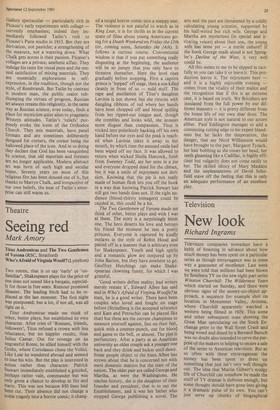Art
Aglow
John McEwen
Every year Annely Juda (Fine Art) concocts the summer's most distinguished gallery exhibition of 20th-century art. Every year one doubts the standard being maintained, and every year with a mixture of loans, old stock and new surprises, it is. Configuration 1910-1940 and Seven Tatlin Reconstructions (till 26 September) proves no exception. It remains predominantly a celebration of the history of abstract art, but the presence of two works by Picasso — especially included in acknowledgment of his centenary — and examples of Leger, Klee and Magritte, make for more of a figurative mix than in previous shows of the series. There are a number of particular delights: most mouth-watering of all, perhaps, a vintage abstract by Mondrian, juggling the primary colours; a fine midterm firework display from Kandinsky, hovering on the verge of depiction; no less than 11 examples in various media (including a 1916 junk collage prescient of Schwitters) by one of those rare Russian pioneers, Ivan Kliun, that the gallery has done so much to bring to light; strong selections of Schwitters and El Lissitzky and delectable watercolours by Leger and Robert Delaunay.
A feast indeed, and yet that is only the half of it. Downstairs is entirely given over to a remarkable piece of artistic archaeology, sponsored by the gallery, in the form of seven constructivist items conceived by another hero of the pre Revolutionary Russian avant-garde, Vladimir Tatlin, reconstructed from the evidence of contemporary and often very hazy photographs by the English sculptor and art historian Martyn Chalk. These illustrations of the originals (all now reckoned destroyed or irretrievable) are exhibited alongside their modern equivalents and demonstrate how accurate as reproductions they surely are. The fact that they cannot amount to more than careful approximations nevertheless does not invalidate their importance. Like a good translation, spirit rather than an' inventory of parts is what must be conveyed, and Martyn Chalk's objects honour that requirement in full. Fifteen years he has spent researching the subject and in so doing has clearly become, at least in the making of these pieces, more Tatlin than himself. The verve, the excitement that the originals must have had, is all there. And how exciting they must have been, how disruptive and astonishing, when they were first shown in 1915. 'Iron, plaster, glass, asphalt etc', 'Wood, glass, tin can etc', 'Wood, wallpaper, iron etc' all stuck together and tacked to the wall.
They owe a large debt to Picasso, as a cross-check with the current Hayward Gallery spectacular — particularly rich in Picasso's early experiments with collage — currently emphasises; indeed they immediately followed Tatlin's visit to Picasso's Paris studio in 1913. But they are derivation, not pastiche; a strengthening of the measure, not a watering down. What Chalk gets across is their passion. Picasso's collages are a private, aesthetic affair. They indulge his taste for visual puns and the sensual satisfaction of mixing materials. They are essentially explorations in selfexpression, in the tradition, though not the style, of Rembrandt. But Tatlin by contrast is modern man, the public zealot tubthumping the virtues of progress. Russian art always retains this religiosity, in the same way as Russian science, even today, finds a Place for mysticism quite alien to pragmatic Western attitudes. Tatlin's 'reliefs' purposely evoke the icons of the Orthodox Church. They mix materials, have panel formats and are sometimes deliberately designed for corners, the corner being the hallowed place of the icon. And in so doing they declare that God has been vanquished by science, that old materials and formats are no longer applicable. Modern abstract t was born of such high and secular hopes. Seventy years on most of this religious fire has been doused out of it, but thanks to Martyn Chalk, and irrespective of our own beliefs, the heat of Tatlin's enterprise can still warm us.

































 Previous page
Previous page